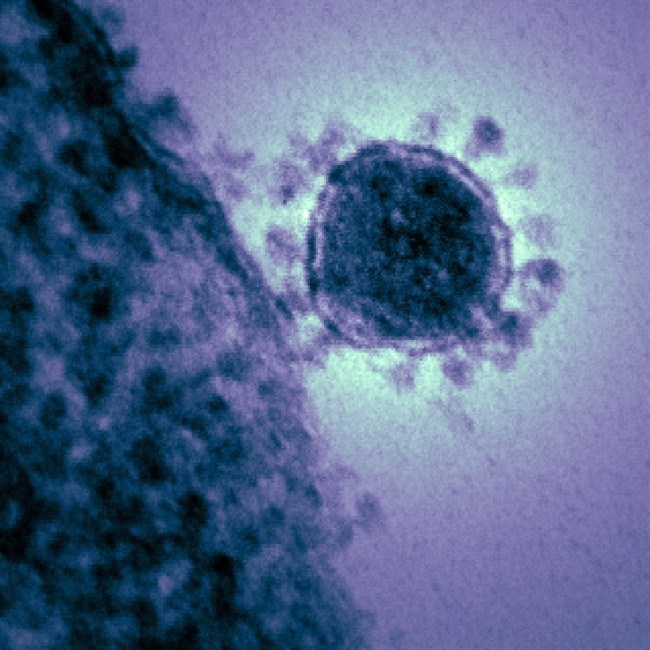TORONTO - A new study reveals that the new SARS-like virus which has been causing infections in the Middle East behaves unusually in laboratory testing.
The unexpected behaviour of the virus may help to explain the pattern of spread of the cases so far, says senior author Christian Drosten, a leading coronavirus expert.
In essence, the new coronavirus is promiscuous, a term the virologists who authored the study use to describe the fact that it will grow in a variety of different types of animal cells, including cells from people, pigs and several species of bats.
That is not true for other known coronaviruses, which typically only grow in cells from the species they infect, says Drosten, who is the director of the institute of virology at the University of Bonn Medical Center, in Bonn, Germany.
Dutch virologist Ron Fouchier agrees that the finding is surprising.
"This is certainly unusual for a (corona)virus to have such a broad cellular host range," says Fouchier, a senior scientist with Erasmus Medical Centre in Rotterdam. Fouchier is also an author of the paper.
"There is something unusual about this virus."
The virus goes by the name hCoV-EMC, which is short for human coronavirus Erasmus Medical Centre. Fouchier's lab was the first to sequence the full genetic code of the new virus.
It is known to have infected at least nine people from April onward, with cases recorded in Jordan, Saudi Arabia and Qatar. Five of the infected people have died.
For this study, the researchers wanted to see if the new virus uses the same cell receptor as the virus that caused SARS. It was also a coronavirus.
Finding out what cells the new virus latches onto would help scientists assess the risk it poses.
For instance, the SARS virus attached to receptors found deep in human lungs. That meant in order to get sick, people had to have been exposed to a large dose of the virus, and have breathed it deep into their lungs.
That probably explains why SARS made many of its victims so very ill; SARS killed roughly 11 per cent of the people it infected.
But it also likely limited the SARS virus's ability to spread easily from person to person and may have helped in the eventual containment of the 2003 outbreak.
The EMC virus does not use the same receptor that SARS does, the scientists found. At the time of the writing of the paper, published in the journal mBio, they hadn't managed to find the receptor the EMC virus uses.
But they did discover that it will grow in cells from five different species of bats, and in cells from pigs and humans. That is "absolutely unique among coronaviruses," they wrote.
The news assuages some concerns and raises others.
Drosten explains that when coronaviruses are found to have jumped into a new species, by the time science has detected the event the viruses have adapted to their new hosts.
SARS is a good example. It is believed the SARS virus came from a similar coronavirus that infects bats. But if you try to infect bat cells with the SARS virus, it won't work. Having switched species, the virus moved on, Drosten says.
"The usual concept for the coronaviruses is that as soon as you see this virus in human, it's actually irrelevant where it came from because the problem is there. We have it in humans," he says.
Given that paradigm — which holds true for other known coronaviruses — experts like Drosten were worried when sporadic cases of human infections with the new virus came to light this fall.
He feared the virus had left its animal reservoir and was spreading from person to person, with mild infections passing under the radar and only the severe cases coming to light.
But given that this virus seems to be able to infect multiple species — at least in the lab — that might suggest a pattern where the geographically and temporally distant cases are being infected from animal sources, not people, Drosten admits.
In some respects, that's a more reassuring idea. But in others, it's not. If the virus is able to infect a number of types of animals, it could continue to make periodic jumps to humans — which could impede containment efforts.
If the EMC virus were to get into animals farmed in the Middle East, for instance, human exposures could be ongoing, Fouchier says.
"From looking at these data . . . you would think the zoonotic potential of a virus like this would be higher than something like the SARS coronavirus, which is more restricted," he says. A zoonosis is an animal disease that crosses the species barrier to infect people.
The risk will depend in part on how well the virus transmits, which at this point is still a mystery. But Drosten says veterinary surveillance should be going on to look for the virus in livestock and wild animals in the Middle East.

